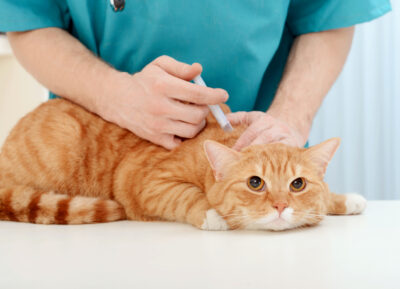Mirtazapine for Cats

Medication details
- Medication type: Tetracyclic antidepressant
- Form: Tablet, Transdermal
- Prescription required? Yes
- FDA approved? Yes
- Brand names: Mirataz (veterinary product); Avanza, Axit, Remeron, Zispin (human products)
- Common names: Mirtazapine
- Available dosages: 7.5 mg and 15 mg tablets; 20 mg/g transdermal
- Expiration range: Transdermal product should be discarded 30 days after opening
Our feline friends often get excited about specific foods. Whenever a can of tuna is opened, cats come running! So when your cat doesn’t seem excited to eat — even something exciting like tuna — they must not be feeling well. Cats should not go without food for more than a couple days, because they can develop a serious condition called fatty liver (hepatic lipidosis in cats). So what will your veterinarian do if your cat stops eating like they normally do? No matter the cause, it is very important for your cat to start eating. To help with this, an appetite stimulant like mirtazapine for cats may be the answer.
What Is Mirtazapine?
Mirtazapine is a tetracyclic antidepressant medication. It was FDA-approved in 1996 for the treatment of moderate to severe depression in humans. Mirtazapine was described as preventing vomiting, reducing anxiety, and increasing appetite (1). For humans, it is available in the United States under multiple brand names, such as Avanza, Axit, Remeron, and Zispin.
In veterinary medicine, mirtazapine has been used off-label in cats. This means that while the medication was not assigned for use in cats by the FDA, many veterinarians prescribed it because they saw the positive effects it could have on their feline patients. In 2018, a transdermal mirtazapine under the brand name Mirataz was FDA-approved and became available in the United States. Mirtazapine is available in all states and is readily available at any veterinary office.
What Does Mirtazapine Look Like?

Mirtazapine tablets are often oval or oblong and white or yellow in color. The transdermal medication is a white ointment that comes out of a tube in a thin line.
What Is Mirtazapine Used For in Cats?
Veterinarians prescribe mirtazapine to cats to stimulate their appetite. Cats who benefit the most from mirtazapine have reduced appetite and weight loss, especially if the underlying reason is a chronic or ongoing disease. Chronic kidney disease is a common reason to give your cat mirtazapine. It decreases nausea as well, which can in turn improve appetite. Mirtazapine can be used short-term (i.e., even a single dose to get your cat on the right track) or chronically.
How Does Mirtazapine Work?
Mirtazapine has multiple effects on the body, and not all its effects are fully understood. Mirtazapine blocks (antagonizes) 5-HT receptors, which are important for the control of vomiting. It increases serotonin and norepinephrine, which are neurotransmitters in the brain (i.e., little chemicals that send signals from cell to cell) that control mood and stress, among other things. These effects result in decreased nausea and vomiting and improve mood so that your cat wants to eat.
How to Give Mirtazapine to Cats
There are two forms of mirtazapine: tablets and transdermal. Tablets are cut into really small pieces. They taste bitter, so covering them with a small amount of cat treat formed around the pill or a very small amount of people food like cream cheese may help. Your cat is unlikely to eat it on their own, since cats who are prescribed this medication tend to have a decreased appetite. If you give your cat the pill form, you may have to “pill” your cat (or place the pill in the back of the mouth and entice your kitty to swallow). Try the following steps:
- Wrap a blanket or large towel around your cat so legs and claws are covered
- Hold your cat on your lap with their butt facing your stomach
- Place one hand with thumb opposite a couple fingers on either side of their upper jaw, just above the fangs
- Using your other hand, use the middle or ring finger to push the lower jaw down, then use your pointer to propel the pill into the back of the mouth
- Gently stroke your cat’s neck multiple times, moving from beneath the head down to the chest
- Alternatively, purchase a “pill popper” and use this plastic tool instead of your hand in step 4.
Whether your cat is stressed by being given tablets or you are when giving them, the transdermal medication may be easier for both of you! Here’s how to administer transdermal mirtazapine for cats:
- Wear disposable gloves
- Using a ruler as a guide (there’s one on the side of the medication box), measure a 1.5 inch strip of medication onto one of your fingers
- Smear all the medication on the hairless underside of one of your cat’s ears
- Alternate which ear you smear. For example, use the right ear for even-numbered days and the left ear for odd-numbered days.
Mirtazapine for Cats Comparison Chart
Below is a chart comparing mirtazapine to three medications that are commonly prescribed to cats for appetite stimulation:
| Mirtazapine | Elura | Cyproheptadine | |
| Medication Type | Tetracyclic antidepressant | Ghrelin receptor | Antihistamine |
| Medication Form | Tablet, transdermal | Liquid | Tablet, liquid |
| Requires Prescription? | Yes | Yes | Yes |
| Dosing Frequency | Once every 1-3 days | Once daily | Twice daily |
| When Does it Start Working? | Average 9 hours (from 1 to 24 hours later) | 1-2 hours | 2-3 days |
| Most Common Side Effects | Vocalizations, dilated pupils, affectionate | Vomiting, diarrhea, salivation | Drowsiness, vocalizations, affectionate |
Mirtazapine for Cats Side Effects
Mirtazapine may have side effects, which could include:
- Excessive vocalization
- Dilated pupils (black central part of the eye enlarges)
- Increased affectionate behavior
- Ataxia, or stumbling when trying to walk
- Lethargy, or less active and drowsy
- Hyperactivity, i.e. excessively active
- Vomiting
If applying the transdermal product to the ears, side effects on the skin may include redness, crust, dryness, fur loss and itchiness of the ears. In rare cases, serotonin syndrome may occur. This could occur if mirtazapine is given with another medication that increases serotonin, such as fluoxetine, or if your cat is more sensitive to mirtazapine and is given a dose of mirtazapine at the higher end. This syndrome could be life threatening, as neuromuscular symptoms like tremors, seizures, and rigid muscles may occur that could keep your cat from breathing normally.
Reactions With Other Drugs and Medications
Some medications are best to not give to your cat at the same time as mirtazapine, such as:
- Effect of mirtazapine is cancelled out if given cyproheptadine
- Increased risk of serotonin syndrome if given with:
- Serotonin-reuptake inhibitors like fluoxetine
- Tricyclic antidepressants like amitriptyline
- Opioids like fentanyl or tramadol
- Serotonin receptor agonist like buspirone
Mirtazapine Dosage for Cats
The appropriate dosing for cats varies depending on their sensitivity to the medication. Bigger cats tend to need more, but dosing is similar to all sizes of cats. For transdermal dosing, all cats receive 2 mg across the ear once daily. For tablets, cats typically take 1/8 to 1/4 of either a 7.5 mg tablet or a 15 mg tablet (0.9375 mg to 3.75 mg). If your cat is receiving a portion of the 7.5 mg tablet, dosing could be once per day or every other day. If your cat is receiving a portion of the 15 mg tablet, dosing could be once every 2 or 3 days. Speak with your veterinarian about dosing for your cat.
Kittens should not be given mirtazapine, except for when your veterinarian has ruled out various causes and has tried other stimulants for appetite. Their smaller body size makes dosing of mirtazapine risky and makes serotonin syndrome more likely.
Mirtazapine Cost
Mirtazapine 15 mg tablets cost around 15 cents each. Mirtazapine 7.5 mg tablets, which are preferred in cats to provide more flexibility in dosing, cost around 60 cents each. Regardless, both tablet sizes are economical with each tablet providing 4-8 doses. Transdermal mirtazapine costs approximately $50 per tube, and each tube lasts 14 days.
Mirtazapine Storage Instructions
None of the mirtazapine forms require refrigeration. Keep in a dry place with a stable, room-temperature environment.
Resources
- https://www.ncbi.nlm.nih.gov/books/NBK519059/









